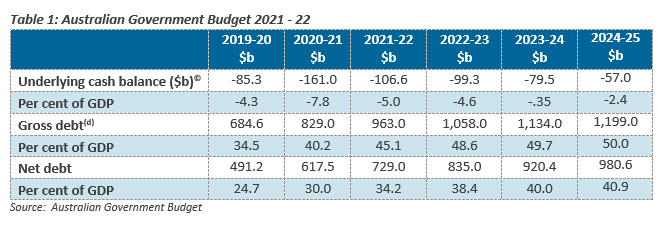By Ken Atchison – Atchison Consultants
Under national cabinet pandemic management, the Federal Government, bear the costs of individual states or territories which decide to lockdown their respective states. It is funded by debt and taxpayers will be on the hook for it in the future.
The latest lockdowns by various states have occurred without any consideration of the financial consequences. It is at the expense of the Federal Government, after all. However, excessive public debt will reduce living standards for all Australians in the future. Servicing the debt when interest rates rise will be a burden on future generations.
In May 2021, the Federal government released a budget for 2021/22, with projections of deficits well into the future. National net public debt had been forecast at $1.3 trillion in 2023/24.
While the Federal Government is the major borrower, the states, in aggregate, account for 29% of public debt, which is well above the long term average of 13%.
Unfortunately, the Reserve Bank of Australia (RBA) has encouraged debt increases. RBA Governor Dr Lowe has expressed no concern at all with states borrowing.
Responsibility for payment though, falls on future generations. Australian debt levels have increased dramatically through state governments imposing draconian restraints on household and business activities in Australia.
In the Federal Government budget, Australian net government debt was projected to rise to $980 billion in 2024/25, being 40.9% of GDP as shown in Table 1.

Net Commonwealth debt was 20% of GDP in 2018/2019. It is forecast to increase to 40% of GDP in 2023/24. This comes to about $36,000 per person.
At the state level, Victoria will be the most indebted at $155 billion net debt, or about $24,000 per person.
When added to Victoria’s “share” of Commonwealth debt, every Victorian will be in debt to the tune of $60,000 and that is before household debt is taken into account.
Lockdowns 5 and 6 in Victoria and lockdown in New South Wales in July and August will increase the net public debt and reduce GDP. Net public debt per person will increase to $61,000. While it may only be a 1.5% increase, this increase took place over two months. A continuing programme of lockdowns will only add to the burden.
This is before acknowledging the cost of the suburban rail loop, now at $100 billion without allowing for cost overruns. Unfortunately, an overrun of 50% on infrastructure projects is almost inevitable based on the track-record of the current government. This will increase the debt per Victorian to about $84,000 should the project proceed.
All this may seem fine for politicians given current interest rates. However, there are consequences for future taxpayers and their dependents.
Currently, real interest rates are negative. A real interest rate is a nominal interest rate less the inflation rate. Through most of history interest rates have exceeded the inflation rate, for obvious reasons. They only persist because of central bank quantitative easing. This is unsustainable.
Increasing debt with, ultimately, higher interest rates payable on debt, will result in reduced government services. Discretion for meeting policy priorities of political parties will be reduced materially.
Weaker economic conditions in Australia, with higher interest rates on debt, will potentially result in a falling AUD. A declining standard of living will emerge from a higher cost of imported goods and services. It will include a higher cost of overseas travel when it is permitted again.
Federal and state public debt does matter. Ultimately servicing debt will involve reducing spending, reducing government services or raising taxes or all three. Excessive public debt will mean declining living standards for future generations of Australians.

